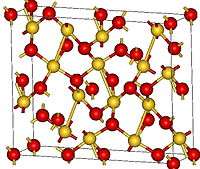Gold(III) oxide
 | |
| Names | |
|---|---|
| IUPAC name
Gold(III) oxide | |
| Other names
Gold trioxide, Gold sesquioxide | |
| Identifiers | |
| 1303-58-8 | |
| ECHA InfoCard | 100.013.748 |
| PubChem | 164805 |
| Properties | |
| Au2O3 | |
| Molar mass | 441.93 |
| Appearance | red-brown solid |
| Density | 11.34 g/cm3 at 20 °C[1] |
| Melting point | 160 °C (320 °F; 433 K) (decomposes) |
| insoluble in water, soluble in hydrochloric and nitric acid | |
| Structure | |
| Orthorombic, oF40 | |
| Fdd2, No. 43[1] | |
| Hazards | |
| NFPA 704 | |
| Except where otherwise noted, data are given for materials in their standard state (at 25 °C [77 °F], 100 kPa). | |
| | |
| Infobox references | |
Gold(III) oxide (Au2O3) is the most stable oxide of gold. It is a red-brown, thermally unstable solid that decomposes at 160 °C.[2] The hydrated form is weakly acidic and dissolves in concentrated alkali to form salts that are believed to contain the Au(OH)4− ion.[2]
Anhydrous Au2O3 can be prepared by heating amorphous hydrated gold(III) oxide with perchloric acid and an alkali metal perchlorate in a sealed quartz tube at a temperature of around 250 °C and a pressure of around 30 MPa.[3]
References
- 1 2 Jones, P. G.; Rumpel, H.; Schwarzmann, E.; Sheldrick, G. M.; Paulus, H. (1979). "Gold(III) oxide". Acta Crystallographica Section B. 35 (6): 1435. doi:10.1107/S0567740879006622.
- 1 2 Greenwood, Norman N.; Earnshaw, Alan (1997). Chemistry of the Elements (2nd ed.). Butterworth-Heinemann. ISBN 0-08-037941-9.
- ↑ Jones, Peter G.; Rumpel, Horst; Sheldrick, George M.; Schwarzmann, Einhard (1980). "Gold(III) oxide and oxychloride". Gold Bulletin (open access). 13 (2): 56. doi:10.1007/BF03215453.
This article is issued from Wikipedia - version of the 6/6/2016. The text is available under the Creative Commons Attribution/Share Alike but additional terms may apply for the media files.
